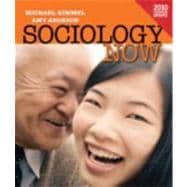
Note: Supplemental materials are not guaranteed with Rental or Used book purchases.
Purchase Benefits
What is included with this book?
Amy Aronson is Assistant Professor of Journalism and Media Studies at Fordham University. She is the author of Taking Liberties: Early American Women's Magazines and Their Readers and an editor of the international quarterly, Media History. She has co-edited several books, including a centennial edition of Charlotte Perkins Gilman's Women and Economics and the two-volume Encyclopedia of Men and Masculinities, which was honored by the New York Public Library with a Best of Reference Award in 2004. A former editor at Working Woman and Ms., her work has also appeared in publications including Business Week, Global Journalist and the Sunday supplement of The Boston Globe.
IN THIS SECTION:
1.) BRIEF
2.) COMPREHENSIVE
BRIEF TABLE OF CONTENTS:
Chapter 1: What is Sociology?
Chapter 2: Culture and Society
Chapter 3: Society: Interactions, Groups, and Organizations
Chapter 4: How Do We Know What We Know? The Methods of the Sociologist
Chapter 5: Socialization
Chapter 6: Deviance and Crime
Chapter 7: Stratification and Social Class
Chapter 8: Race and Ethnicity
Chapter 9: Sex and Gender
Chapter 10: Sexuality
Chapter 11: Age: From Young to Old
Chapter 12: The Family
Chapter 13: Economy and Work
Chapter 14: Politics and Government
Chapter 15: Religion and Science
Chapter 16: The Body and Society: Health and Illness
Chapter 17: Education
Chapter 18: Mass Media
Chapter 19: Sociology of Environments: The Natural, Physical, and Human Worlds
COMPREHENSIVE TABLE OF CONTENTS:
Chapter 1: What is Sociology?
Sociology: A Way of Seeing
Doing Sociology
Where Did Sociology Come From?
Contemporary Sociology
New Issues, New Lenses
Sociology and The Future, Sociology and You
Chapter 2: Culture and Society
Culture
Elements of Culture
Dimensions of Culture
Core Elements of Culture: Norms and Values
Values
Cultural Change
The Future of Culture
Chapter 3: Society: Interactions, Groups, and Organizations
The Social Construction of Reality
Elements of Social Structure
Groups
Organizations
Chapter 4: How Do We Know What we Know? The Methods of the Sociologist
Sociology as a Social Science
Why Sociological Methods Matter
Sociology and the Scientific Method
Doing Sociological Research
Types of Sociological Research Methods
Social Science and the Problem of "Truth"
Issues in Conducting Research
Emergent Methodologies
Chapter 5: Socialization
Socialization and Biology
Socialization in Action
Stages in Socialization
Agents of Socialization
Socialization and the Life Course
Gender Socialization
The Future of Socialization
Chapter 6: Deviance and Crime
What is Deviance?
Conformity and Social Control
Deviance and Social Coherence
Deviance and Crime
Types of Crime
Crime in the United States
The Criminal Justice System
Globalization and Crime
The Future of Deviance and Crime
Chapter 7: Stratification and Social Class
Social Stratification
Social Class
Poverty
Social Mobility
Global Inequality
Class Identity and Class Inequality in the Future
Chapter 8: Race and Ethnicity
Distinguishing Between Race and Ethnicity
The Sociology of Race and Ethnicity
Prejudice
Discrimination
Theories of Prejudice and Discrimination
Ethnic Groups in the United States
Ethnicity and Conflict
Race in the Future
Chapter 9: Sex and Gender
Sex and Gender: Nature and Nurture
The Biology of Sex and Gender
Exploring Cross-Cultural Variations of Sex and Gender
Becoming Gendered: Learning Gender Identity
Gender Inequality: Global and Local
Gender Inequality in the United States
The Politics of Gender
Outlook on Gender Equality
Chapter 10: Sexuality
Sexual Socialization
Researching Sexuality
Modern Sex Research
Changing Sexual Attitudes
Gender and Sexual Orientation
Sexual Inequality
The Politics of Sexuality
Conclusion: The Future of Sexuality
Chapter 11: Age: From Young to Old
Age and Identity
Age and Inequality
Boomers, Busters, and Boomlets: The Generations of Youth
Youth and Inequality
Getting Older and Getting Better? Youth and Age Down the Road
Chapter 12: The Family
The Family Tree
Family and Ethnicity
Developing and Establishing Families
Parenting
Divorce and Remarriage
Family in the Future
Chapter 13: Economy and Work
Theories of the Economy
Economic Development
The American Economy
Economic Systems
Corporations
Work
Diversity in the Workplace
The Future of Work
Chapter 14: Politics and Government
Politics and Power
Political Systems
Political Participation
Political Parties
Political Life
Extreme Politics
Everyday Politics
Political Life in the 21st Century
Chapter 15: Religion and Science
Comparing Religion and Science
What Does Religion Do?
Religious Groups
Religions of the World
Religion and Modern Society
Religion in the United States
Science as an Institution
Science and Religion in the 21st Century
Chapter 16: The Body and Society: Health and Illness
The Beautiful Body
Changing the Body
The Healthy Body
The Sick Body
The Social Organization of Health
Race, Class, and Gender and Health
The Global Distribution of Health and Illness
Conventional and Alternative Healthcare
Healthcare Reform
Living Longer -- and Healthier?
Chapter 17: Education
Sociology and Education
Education and Democracy
The Curriculum Changes
Education in the Developing World
Education and Mobility
Schools and Inequality
School Reform
Higher Education
The Wave of the Future
Chapter 18: Media
What is Mass Media?
Types of Mass Media
Media Production and Consumption
Using Mass Media
Regulating Media
Globalization of the Media
Not Just Another Show: Media Today and Tomorrow
Chapter 19: Sociology of Environments: The Natural, Physical, and Human Worlds
The Human Environment
Population Growth
The Urban Environment
Human Ecology
The Natural Environment
Environmental Threats
Awaiting the Next One
The New copy of this book will include any supplemental materials advertised. Please check the title of the book to determine if it should include any access cards, study guides, lab manuals, CDs, etc.
The Used, Rental and eBook copies of this book are not guaranteed to include any supplemental materials. Typically, only the book itself is included. This is true even if the title states it includes any access cards, study guides, lab manuals, CDs, etc.